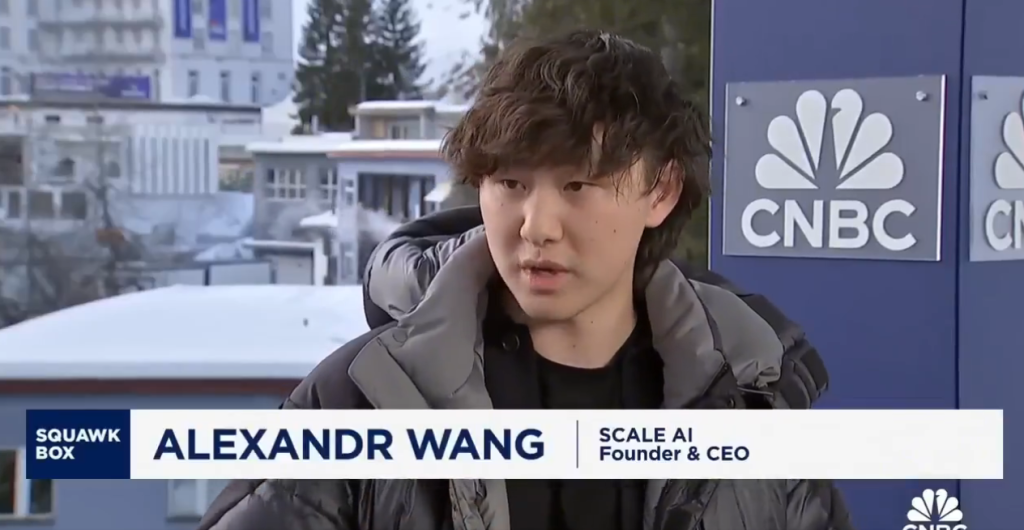Scale AI CEO Alexandr Wang Claims Chinese AI Lab DeepSeek Possesses 50,000 Banned NVIDIA H100 GPUs, Circumventing U.S. Export Controls
DAVOS, SWITZERLAND , Scale AI CEO Alexandr Wang has ignited geopolitical tensions in the artificial intelligence sector by alleging that DeepSeek, a rising Chinese AI lab, has stockpiled approximately 50,000 NVIDIA H100 GPUs , advanced chips banned for export to China under U.S. sanctions.

The bombshell claim, made during a CNBC interview at the World Economic Forum in Davos, raises urgent questions about the efficacy of American semiconductor export controls and China’s accelerating AI capabilities .
Wang, whose company supplies training data to OpenAI, Google, and Meta, described DeepSeek’s progress as “earth-shattering,” citing its recent release of DeepSeek-R1, an open-source reasoning model that reportedly matches or exceeds OpenAI’s GPT-4o in benchmarks.
“China has significantly more H100s than people think,” Wang asserted, framing the U.S.-China rivalry as an escalating “AI war” .
The allegation aligns with reports of a clandestine supply chain bypassing U.S. restrictions. Despite bans on NVIDIA’s top-tier chips, Chinese entities have reportedly acquired H100s and H200s via smuggling networks, third-party distributors, and pre-sanction stockpiling.
For instance, DeepSeek’s parent company, High-Flyer Quant, allegedly amassed tens of thousands of NVIDIA A100 GPUs before sanctions took effect, with estimates ranging from 10,000 to 50,000 units .
The implications are stark: 50,000 H100s could theoretically enable China to train sophisticated AI models at scale, undermining U.S. efforts to stifle its technological ascent. DeepSeek’s breakthroughs , including models built with older H800 chips at 1/10th the cost of U.S. counterparts , already challenge Silicon Valley’s dominance .
Experts warn that export controls may inadvertently fuel Chinese innovation. “Sanctions have forced them to prioritize efficiency,” noted Carnegie Endowment researcher Matt Sheehan. DeepSeek’s engineers, for example, optimized training processes to reduce GPU strain, achieving benchmark parity with minimal resources .
NVIDIA and the Semiconductor Industry Association (SIA) have criticized U.S. policies, arguing that restrictions harm American competitiveness while pushing China toward self-reliance . Wang echoed this sentiment, urging the U.S. to “unleash energy” to maintain its edge, even as President Trump’s $500 billion “Stargate” AI infrastructure project aims to counter China’s momentum .
The revelation underscores a pivotal moment in the global AI race. With DeepSeek’s models now open-source and accessible to resource-limited developers worldwide, the balance of power may be shifting , and Washington’s sanctions strategy risks backfiring spectacularly .
What are NVIDIA H100 Chips?
The NVIDIA H100 is a cutting-edge graphics processing unit (GPU) designed to power the most advanced AI systems, enabling rapid training of large language models (LLMs) like OpenAI’s GPT-4.
Its unparalleled computational speed and efficiency make it a gold standard for AI development, with each chip costing tens of thousands of dollars. U.S. export controls, enacted in 2022, explicitly ban sales of the H100 to China over fears its military could harness such technology for autonomous weapons, surveillance, or cyberwarfare.
This is why Scale AI CEO Alexandr Wang’s claim, that Chinese lab DeepSeek has amassed 50,000 H100s, is so explosive: it suggests a systemic evasion of sanctions, granting China access to computing power that could accelerate its AI capabilities despite U.S. efforts to curb them.
With 50,000 H100s, DeepSeek could theoretically train AI models rivaling those of Silicon Valley giants, eroding America’s strategic advantage and raising urgent questions about the viability of semiconductor restrictions in an era of globalized tech supply chains.
The revelation underscores a high-stakes paradox: sanctions meant to slow China’s AI progress may instead be pushing it toward self-reliance, or clandestine innovation.